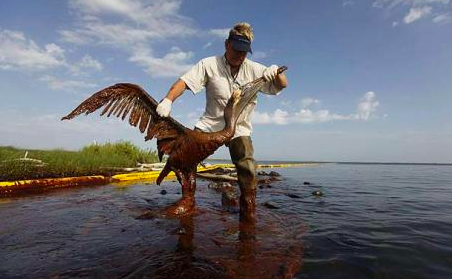
Photo: Associated Press
The National Audubon Society published a new report yesterday calling for the largest ecosystem restoration effort ever attempted — a $1.7-billion slate of distinct restoration projects spanning the states of Mississippi, Texas, Alabama, Louisana, and Florida. The funding for these projects is available due to the $20B settlement in the Deepwater Horizon oil spill litigation.
- Audubon recommends in its report 16 state-based, 10 region-wide and four open ocean projects, which
together total more than 136,000 acres of restored or protected habitat for bird and human communities from south Texas to the
Florida Keys. - The report identifies specific projects and programs that Audubon believes are critical to helping restore the region and its wildlife from devastating coastal erosion, oil spills, and other environmental and man-made disasters.
- Over the last 80 years, more than 1,800 square miles of coastal forests, marshes, beaches and barrier islands have turned into open
water in Louisiana alone, putting more than 2 million people at risk of flooding and threatening vital habitat on which birds and other
species depend.
“The challenges are huge, but we have an enormous opportunity to save much of the Gulf Coast for both birds and people. We can’t afford to blow this,” David Yarnold, President and CEO of National Audubon Society, said in a statement.
In Florida, for example, the report recommends:
- a $5.3-million project called the Cape Sable Restoration, which would “create, restore, and enhance coastal wetlands” in Everglades National Park. The program area impacts species ranging from Reddish Egrets to Roseate Spoonbills,
- a $3.3-million project is recommended to protect and conserve habitats in Hillsborough County. That’s the Richard T. Paul Alafia Bank Bird Sanctuary Breakwaters, and
- a $2.2-million project called Greater Tampa Bay Waterbird Rookeries Protection Initiative would protect habitats. The project stems from an oil spill that disrupted bird nesting.
Why This Matters: The government will have many, many projects to choose from when deciding how to use the Gulf Oil Spill settlement money. I (Monica) was part of the team of state and federal officials that chose the first slate of projects, and even with ample funds, the competition among projects is very tough. The $20b will go fast — especially when you consider how much ecological harm was caused by the spill and how degraded the environment had become even before that. Reports like this one are critically important to help unify public support behind the most ecologically important projects — rather than the politically expedient ones. This is a “once in a generation” opportunity to heal the Gulf. It is important to maximize the environmental benefits in order to rebuild and sustain the natural resource economy of the Gulf for the foreseeable future.
To Go Deeper: Read the full 16-page Audubon Report here.
February 13, 2019 » Audubon, birds, BP, Deepwater Horizon, Gulf of Mexico, oil spill, restoration


